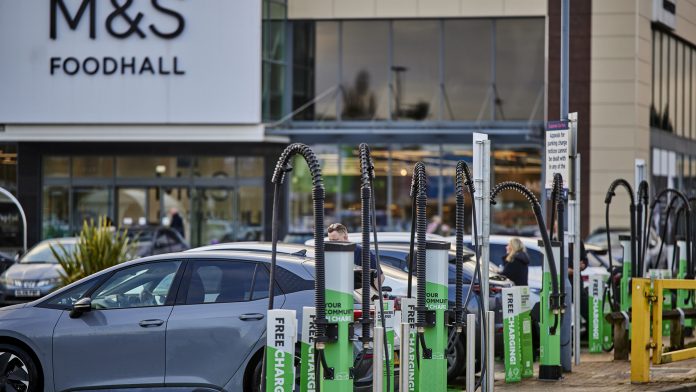Asif Ghafoor, CEO of Be.EV, discusses why the UK is failing to build enough EV charging points and what steps need to be taken to reach the government’s targets by 2030 and ensure our EV infrastructure network is fit for purpose.
It’s an exciting time to be involved with EV charging infrastructure. The pace of the installation of charging points has been increasing rapidly over the last few years – according to ZapMap, installations were 45% higher last year than in 2022.
Despite Rishi Sunak’s environmental policy purge, the zero-emissions vehicles (ZEV) mandate still suggests that 80% of UK car sales will be electric by 2030, meaning demand for new chargers isn’t going anywhere.
So what’s the problem? Whilst the pace of installation has increased, we still only have roughly 53,000 public chargers. Assuming the Government’s target of 300,000 public chargers by 2030 is achievable (whether this is the case is a discussion for another day), the rate of building will need to increase dramatically.
There’s a stark divide between the number of chargers installed in London and the rest of the country. This is combined with a short-sighted reliance on deploying government grants to install ‘slow’ lamppost chargers. For those who don’t know, a lamppost charger can take up to 14 hours to charge a car fully, while an ultra-paid charger can do this in less than 30 minutes. This means that even if we reach the magic 300,000 mark by 2030, we’ll have an EV infrastructure network that isn’t fit for purpose.
Fortunately, this doesn’t have to be our EV charging fate. We can turn this around to create infrastructure that could be the envy of the world, but several changes will need to happen.
Get rid of the red tape
In order to get closer to the government’s 2030 targets, we need to install 110 EV chargers a day compared to the current rate of 40 a day. The main problem causing the holdup is the amount of legislation and misguided public funding.
For example, the Local EV Infrastructure (LEVI) Fund can grant each council £1m to build new EV charging infrastructure, but the bureaucracy in the public sector means that councils sit on this money for years at a time before employing consultants to tell them that it’s only enough money for about 5% of their charging needs. Schemes like these have been implemented with good intentions but have created a mess – slowing down the rollout, not hastening it.
Instead of getting in the way, I believe the Government should give councils mandatory requirements to have a certain number of different types of chargers and let the private sector handle it. We in the private sector have the experience to know the common problems people face when putting chargers in and the expertise to put the right infrastructure in the right places; we just need less friction.
You can’t just put EV chargers anywhere
If I had a pound for every time someone made plans to install chargers in an area that didn’t have enough power, I’d probably have enough money to build 300,000 EV chargers myself! Unfortunately, the reality we face is that the UK grid is outdated, so there’s only so much power to go around. There is more than enough power to reach the Government’s target, but we need to be more strategic about where we place chargers.
We also need to pay more attention to where this power comes from; if the power for an EV charger comes from fossil fuels, then this defeats the whole environmental argument behind the electric transition. Fortunately, it is possible to trace exactly where your power comes from, so it’s imperative that chargers are also put in places where you can guarantee that green energy is being used to top up EVs.
Finally, we need to address the huge disparity between the number of chargers in London and elsewhere in the UK – there are currently more chargers inside the M25 than the rest of the nation combined. If we want a network that’s fit for purpose – one that doesn’t fuel concerns about ‘range anxiety’ – we must consider the forgotten regions. Everyone in the UK should have easy access to EV charging, not just those in city centres.
Say no to lampposts
Councils all too often take the quick and easy option of installing ‘fast’ lamppost chargers as they are cheaper to install. It’s an easy way of getting a headline, but it’s short-sighted. Contrary to the name suggests, these chargers are very slow, resulting in one person taking up the charger for hours at a time. On top of this, they’ll need to be replaced in a few years, either because they’re broken or because vehicle batteries have improved to the point where ‘fast’ chargers are obsolete.
To make a sustainable infrastructure that works for everyone, we should build community hubs on public and private land consisting of rapid and ultra-rapid chargers where drivers can get up to 80% charge in as little as half an hour. This way, more people can conveniently incorporate a quick charge into their daily routine. Putting these hubs near shops, or even putting shops in these hubs, can also create jobs and provide a boost to the local economy.
Our mindset needs to change when it comes to EV charging. We need less red tape from power network owners and more public-private partnerships like the ones we built with North West councils. All is not lost, and the UK can have an EV network which is the envy of the world – provided we remove the unnecessary bureaucracy, pay more attention to where we place our chargers and create community hubs where the end drivers are part of the decision making, we can make a network that fits the needs of everyone in the UK. Who doesn’t want that?









